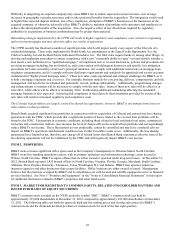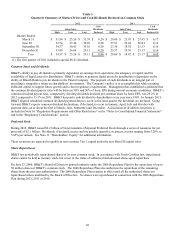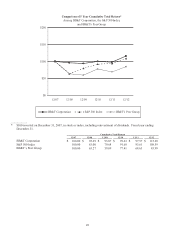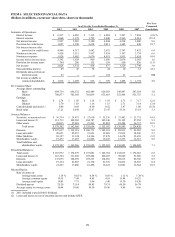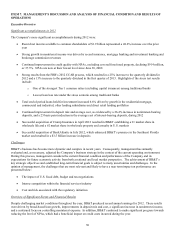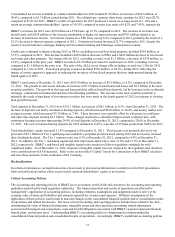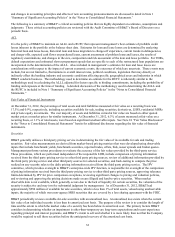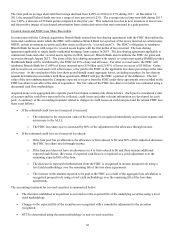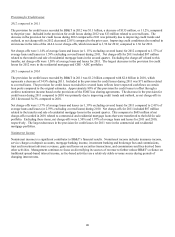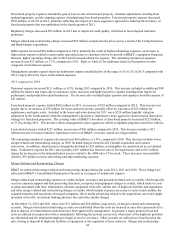BB&T 2012 Annual Report Download - page 57
Download and view the complete annual report
Please find page 57 of the 2012 BB&T annual report below. You can navigate through the pages in the report by either clicking on the pages listed below, or by using the keyword search tool below to find specific information within the annual report.35
2012 compared to 2011
For 2012, net interest income on an FTE-adjusted basis totaled $6.0 billion, compared with $5.7 billion in 2011. Net interest
income on an FTE-adjusted basis increased 6.2% in 2012 compared to 2011. The increase in net interest income was
primarily driven by lower funding costs, which declined $319 million compared to 2011. The improvement in funding costs
reflects a 25 basis point reduction in the average cost of interest-bearing deposits for 2012 compared to the prior year and the
2012 redemption of all junior subordinated debt to unconsolidated trusts. Net interest income also benefited from the growth
in average earning assets, which more than offset the negative impact of lower yields on new loans.
The FTE-adjusted NIM is the primary measure used in evaluating the gross profit margin from the portfolios of earning
assets. The FTE-adjusted NIM was 3.91% in 2012 compared with 4.06% in 2011. The decline in the NIM primarily reflects
the runoff of higher yielding covered loans and lower yields on new loans, partially offset by the lower funding costs
described above.
Management expects NIM to be in the mid 3.70s% range in the first quarter of 2013 as a result of lower rates on new earning
assets and the runoff of covered loans, partially offset by lower funding costs and improved asset mix. Deposit costs are
expected to continue to trend lower in 2013, which would benefit net interest income.
The FTE yield on the total securities portfolio was 2.64% for the year ended December 31, 2012 compared to 2.67% for the
prior year. The decrease reflects a higher volume of lower yielding RMBS securities issued by GSEs.
The average annualized FTE yield for 2012 for the total loan portfolio was 5.35% compared to 5.87% for the prior year. The
decrease was primarily due to the runoff of higher yielding covered loans and a higher volume of new loans originated at
lower rates.
The average rate paid on interest-bearing deposits dropped to 0.43% during 2012, from 0.68% in 2011. This improvement
was a result of lower rates on interest-bearing deposits, including a 56 basis point reduction in the cost of certificates and
other time deposits and a 13 basis point reduction in the cost of money market and savings accounts.
The rates paid on average short-term borrowings declined from 0.27% in 2011 to 0.26% during 2012. At December 31,
2012, the targeted Federal funds rate was a range of zero percent to 0.25%. The average rate on long-term debt during 2012
was 3.02%, a decrease of 38 basis points compared to the prior year. This reduction was primarily due to the redemption of
all higher cost junior subordinated debt to unconsolidated trusts during 2012 and the related benefit associated with
accelerated amortization of derivatives that were unwound in a gain position.
2011 compared to 2010
For 2011, net interest income on an FTE-adjusted basis totaled $5.7 billion, compared with $5.5 billion in 2010. Net interest
income on an FTE-adjusted basis increased 3.6% in 2011 compared to 2010. The increase in net interest income was driven
by lower funding costs, which declined $418 million compared to 2010. The improvement in funding costs reflects a more
favorable mix of funding liabilities, benefits from the accelerated amortization of derivatives that were unwound in a gain
position and decreases in rates paid on deposits. The improvement in funding costs more than offset lower yields on new
loans and securities. In addition, net interest income was higher due to better performance from loans and securities acquired
in the Colonial acquisition as cash flow expectations improved from the prior estimates.
The FTE-adjusted NIM is the primary measure used in evaluating the gross profit margin from the portfolios of earning
assets. The FTE-adjusted NIM was 4.06% in 2011 compared with 4.03% in 2010. This improvement primarily reflects the
higher yields on covered loans and securities and lower funding costs.
The FTE yield on the total securities portfolio was 2.67% for the year ended December 31, 2011 compared to 3.89% for the
prior year. The decrease was primarily the result of management’ s efforts to deleverage and de-risk the portfolio during
2010. The securities purchased included floating rate and other securities with lower yields. The yield on the securities
portfolio benefited from higher yields on covered securities due to the impact of duration adjustments in the prior year.
The average annualized FTE yield for 2011 for the total loan portfolio was 5.87% compared to 5.88% for the prior year. The
slight decrease was primarily due to new loan volumes originated at lower rates, partially offset by the acquired loans from
the Colonial transaction, which have produced higher yields due to better than expected performance.
The average rate paid on interest-bearing deposits dropped to 0.68% during 2011, from 1.05% in 2010. The decline was a
result of the decrease in relatively higher-rate CDs and management’ s ability to lower rates on other deposit products.


